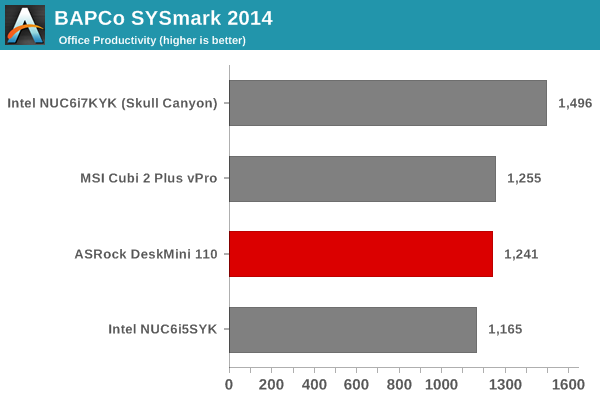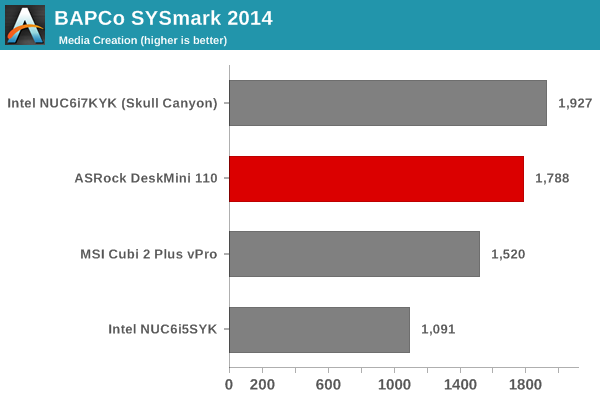ASRock DeskMini 110 mini-STX PC Review
by Ganesh T S on June 8, 2016 8:45 AM ESTPerformance Metrics - I
The ASRock DeskMini 110 was evaluated using our standard test suite for small form-factor PCs. Not all benchmarks were processed on all the machines due to updates in our testing procedures. Therefore, the list of PCs in each graph might not be the same. In the first section, we will be looking at SYSmark 2014, as well as some of the Futuremark benchmarks.
BAPCo SYSmark 2014
BAPCo's SYSmark 2014 is an application-based benchmark that uses real-world applications to replay usage patterns of business users in the areas of office productivity, media creation and data/financial analysis. Scores are meant to be compared against a reference desktop (HP ProDesk 600 G1 with a Core i3-4130, 4GB RAM and a 500GB hard drive) that scores 1000 in each of the scenarios. A score of, say, 2000, would imply that the system under test is twice as fast as the reference system.




SYSmark scores are heavily dependent on the CPU in the system. Here, we see the 65W TDP Core i5-6500 come behind the 45W TDP Core i7-6770HQ, primarily due to the hyperthreading (4C/8T) features of the latter. Note that the Core i5-6500 is a 4C/4T CPU. Other than that, the DeskMini that we built has no trouble proving to be better at business workloads compared to systems equipped with lower TDP CPUs.
Futuremark PCMark 8
PCMark 8 provides various usage scenarios (home, creative and work) and offers ways to benchmark both baseline (CPU-only) as well as OpenCL accelerated (CPU + GPU) performance. We benchmarked select PCs for the OpenCL accelerated performance in all three usage scenarios. These scores are heavily influenced by the CPU in the system. The aspects noted in the SYSmark 2014 subsection apply here too. The DeskMini comes second to Skull Canyon, but has no trouble being better than the other systems in the comparison list.



Miscellaneous Futuremark Benchmarks





The 3D benchmarks present a different story, because the HD Graphics 530 is not as powerful as the GPUs in either Skull Canyon (Iris Pro with eDRAM) or even the U-series models for many workloads.
3D Rendering - CINEBENCH R15
We have moved on from R11.5 to R15 for 3D rendering evaluation. CINEBENCH R15 provides three benchmark modes - OpenGL, single threaded and multi-threaded. Evaluation of select PCs in all three modes provided us the following results. The Core i5-6500's single threaded performance is top of the line, thanks to the high TDP / clock speed. However, absence of hyperthreading allows Skull Canyon (Core i7-6770HQ) to sneak ahead in the multi-threaded case. The OpenGL results lend further credence to the analysis of the GPU capabilities made in the previous subsection.













85 Comments
View All Comments
r3loaded - Wednesday, June 8, 2016 - link
Yeah, MXM was invented to make life easy for OEMs, not consumers.Flunk - Wednesday, June 8, 2016 - link
I think the ship has sailed on that idea, people want smaller and smaller notebooks, not huge ones with huge upgradability.CharonPDX - Wednesday, June 8, 2016 - link
Heck even a transverse (on a riser, across the top of the CPU,) half-height, short-length PCIe x16 slot would be nice, there are "decent", (although not "super powerful) video cards available for half-height, short-length slots.Valantar - Wednesday, June 8, 2016 - link
Thunderbolt 3 alongside similarly sized (stackable?) (MXM-based) external GPUs would be better. Want a small system with just what you need for office/HTPC duty? Skip the GPU. Want a compact gaming rig? Get the extra chassis and (given proper availability and firmware standardization) whatever MXM GPU you want. You could easily fit the "MXM+" GTX 980 (and thus 1080, whenever it's out) in a 5" by 5" form factor, and cooling would be a breeze with a heatsink filling two dimensions of the chassis fitted with a downward blowing 120mm fan.marc1000 - Thursday, June 9, 2016 - link
MXM has lots of issues.I believe if you wanna go this small, it is better to stick with NUCs. if you need some more power, go for mITX + standard GPU.
Calista - Sunday, June 12, 2016 - link
Problem is a mITX case could easily handle a 1000 watt system, going with a full-sized ATX PSU and a high-end GPU/CPU combo and a large bunch of drives. It would be noisy when going full tilt, but it would be doable. What people seem to be asking for is a <200 watt tiny system with interchangeable parts. A 200 watt TDP would allow for a small but efficient PSU to fit within a small case, a 65W CPU and a 100 watt GPU, meaning even a modern high-end GPU like the GTX 970.The mSTX form factor just sounds like the answer to a question no one has asked.
repoman27 - Friday, June 10, 2016 - link
The switch to HBM and stacking the memory and GPU on interposers will enable socketed GPUs in near future. Hopefully that becomes a thing.Namisecond - Wednesday, July 6, 2016 - link
You'd have the same problems with MXM there as you do with them on laptops, with maybe marginally more volume for a cooling system.MXM was not designed to be a user serviceable interface. The sooner you realize that, the happier you'll be. :3
SeanFL - Wednesday, June 8, 2016 - link
Glad to see more vendors gearing up in the small space PC's. Have changed over to NUC's and other small form factors in the house and at work and they work fantastic for almost everything. The monster 6 core machine (i7-5930k) only gets used for video editing now.blackice85 - Wednesday, June 8, 2016 - link
Agreed, I'm glad that these have become pretty viable now. I'm looking to replace my big PC with a smaller machine as well, but would like to still do some medium-ish quality gaming on occasion. I'm hoping the new AMD Zen APUs next year fit the bill, I'll have to see how they review. It would just be cool if a discrete GPU wasn't really a requirement anymore.